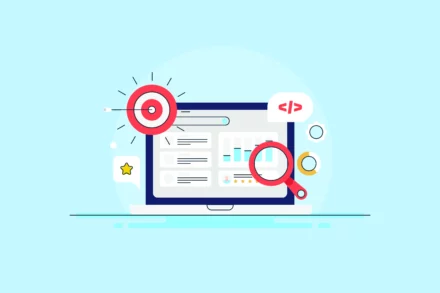How to Improve SEO for Your eCommerce Product Pages

As an increasing number of eCommerce sites vie for a piece of the estimated $6.3 trillion market it is more important than ever that your site is properly optimised.
Free download: A Complete Guide to SEO Audits
Improve Your Product Page SEO
Optimisations for product mages aren’t too dissimilar to those for other types of web pages. However, there are a few extra things you need to consider.
Below are our top ten things you can do to improve SEO for your product pages:
Do your keyword research
Researching and producing a good keyword strategy will give you a solid foundation to build your optimisations on. Don’t fall into the trap of focusing only on high-volume keywords, instead make sure to use those with the most relevancy for your specific product offering.
As product pages have transactional intent, your targeted keywords should too. This will allow you to optimise these pages for users ready to buy.
If you have active paid campaigns, you can use this data in your research to incorporate terms with high CTR (click-through rate) into your metadata.
Optimise your metadata
Titles and meta descriptions are some of the most important elements of your page. They are the first bit anyone sees and are your opportunity to grab their attention and clicks. The page title and meta description should include:
- A product-specific targeted keyword
- The name of the product
- The brand of the product (and your proprietary brand)
- Important product-specific information like model number or size/weight
- A call to action, e.g. “shop now”, “buy online today”, “find out more” etc.
Including these elements will ensure users can see straight away if your product is what they are looking for.
Write unique meta and product descriptions
Unique content for all product pages is essential. Not only does Google prefer and prioritise unique content but it is also an opportunity to take advantage of SEO. Each product and meta description is prime real estate for branded and non-branded keywords. However, it’s important not to overstuff this content with keywords, instead make sure they a relevant and work seamlessly with the helpful information you are providing.
Include Internal linking
It’s well known that including internal linking on your site shares page authority and improves the user experience. However, eCommerce product pages are often neglected in this branch of SEO. Some of these pages can drive a lot of traffic and sharing that across your product range can help improve the ranking of your whole site.
Share customer reviews
Including testimonials and customer reviews on your product pages is a great way of building trust with users and search engines alike. These elements can also help to provide unique content on the page, just make sure they are marked up with the review schema. However, you should not rely entirely on this kind of copy to fill the requirement for unique content, it should instead be part of a whole strategy.
Add useful FAQs
Google loves high-quality content that meets users’ needs and answers their queries. Including well-optimised, product-focused content and helpful FAQs on your product pages will satisfy this requirement and provide a much better user experience.
Use structured data
Using the right structured data on your page can do wonders for getting your brand into the rich snippets section of the search engine results pages (SERPs). Including both product schema and review schema in your product pages can help to drive impressions and clicks. This in turn improves your CTR and drives more sales.
Test your landing pages
Figuring out the right configuration for your product page is just as important as making sure you’re using the right keywords and structured data. Providing a good user experience can be the difference between a sale and a high bounce rate due to frustration.
Testing different variations in page layout is a great way to see what works and what doesn’t. You can use tools like AB Tasty and Optimizely to run these tests, gaining valuable insight into page usability.
Reduce page load times
As more people are using mobile devices (this includes phones and tablets) to do their online shopping it is essential that your site is optimised for this. Fast-loading pages are a huge part of the mobile experience. You want to get your content in front of potential customers as quickly as possible, there is nothing more frustrating than trying to buy a coveted product and having to wait forever for the page to load. In fact, slow-loading pages are one of the biggest causes of a high bounce rate.
All elements ‘above the fold’ (the top part of the page that fits on the screen) should ideally load within 3 seconds or less.
Do a technical page audit
Product pages can face a raft of technical issues including:
- Duplicated metadata
- Slow page load times
- Faceted URLs
- Broken links
- 404 errors or unnecessary redirects
- Missing structured data
The best way to find, and fix, these issues is to is to run an audit of your site. You can run basic audits by pulling data from tools like Google Search Console. However, if you want something in-depth with the solutions you need then it’s best to enlist the help of experts like QueryClick.
You can find out more about technical SEO for your business in our Complete Guide to Technical SEO for eCommerce.
If you’d like to find out how the QueryClick team can help you build and implement the perfect SEO strategy for your business get in touch today or download our brochure.
What makes QueryClick different?
Download our services brochure to find out.
Own your marketing data & simplify your tech stack.
Have you read?
If there’s one thing SEO experts are used to, it’s turbulence and uncertainty. With Google’s AI Overviews arriving in the UK, a US judge ruling that Google’s search monopoly is...
According to Marketing Tech News, a staggering 92% of Marketers said that integrating AI into their marketing is the number one trend for 2024, and this trend doesn’t show any...
I have worked in SEO for 12+ years and I’ve seen the landscape shift a dozen times over. But the rollout of generative search engines (GSEs) feels like the biggest...



